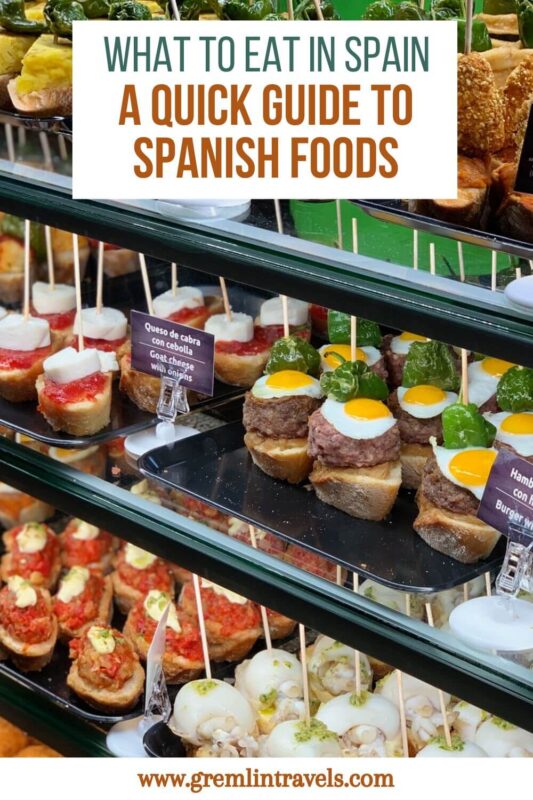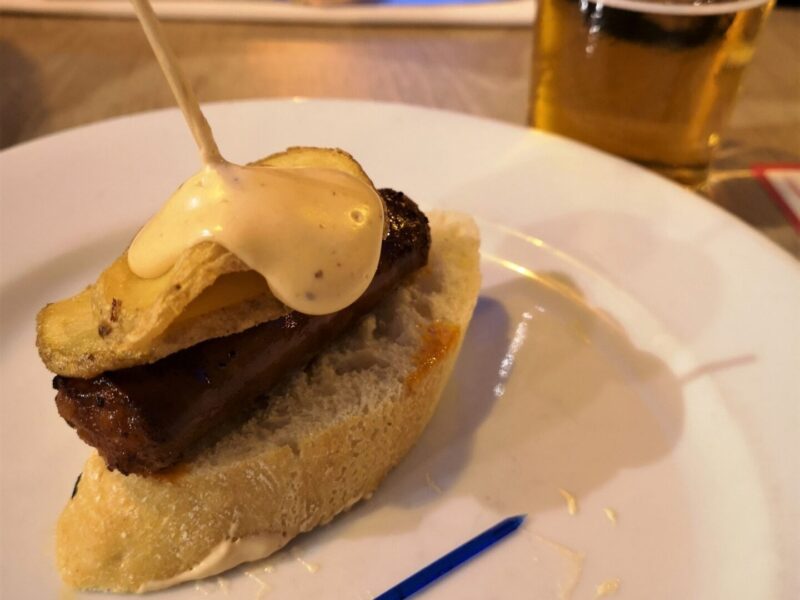If you’re heading to Spain then chances are you’re looking to sample some of Spain’s delectable foods. From tapas to paella, Spain’s local cuisine is world-famous and is a celebration of its varied landscape and produce. With amazing pork, cured meats, fresh fish, homegrown rice and sun-ripened vegetables, there’s something in the world of Spanish food for everyone.
However, if you’re new to Spain and its vast gastronomy then navigating its dishes and various cuisines can be challenging. We love Spanish food and have created a quick guide to some of the most popular and delicious Spanish food varieties to sample on your next visit to Spain.
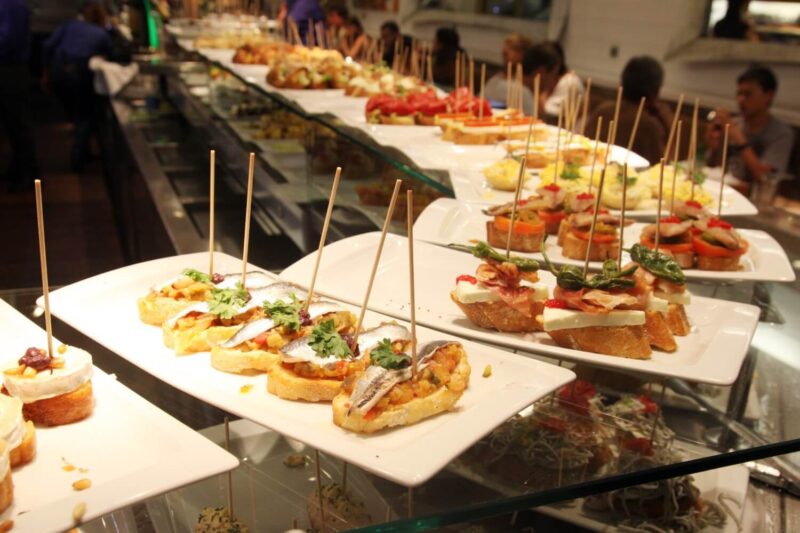
Tapas
Spanish tapas is famous all over the world for its delicious flavours and delightful small plates. Tapas can consist of many different types of dishes from traditional meat, fish and vegetables to more modern and creative dishes. Dishes can be cold or hot. They are usually shared and are a social meal often involving plenty of wine. It’s common to hop between tapas bars, sampling a few dishes in each bar before moving on to the next.
It is still highly debated where tapas originated from. Many believe it to have originated in Spain’s Andalusia region. In any case, the word tapas comes from the Spanish verb ‘tapa’ which means to cover. It is understood that the concept came to fruition many years ago when bar staff would cover customers’ glasses of sherry with a piece of bread or ham on top, to stop the flies from getting into the sherry. From there, customers enjoyed the addition of food with the drink and tapas was born.
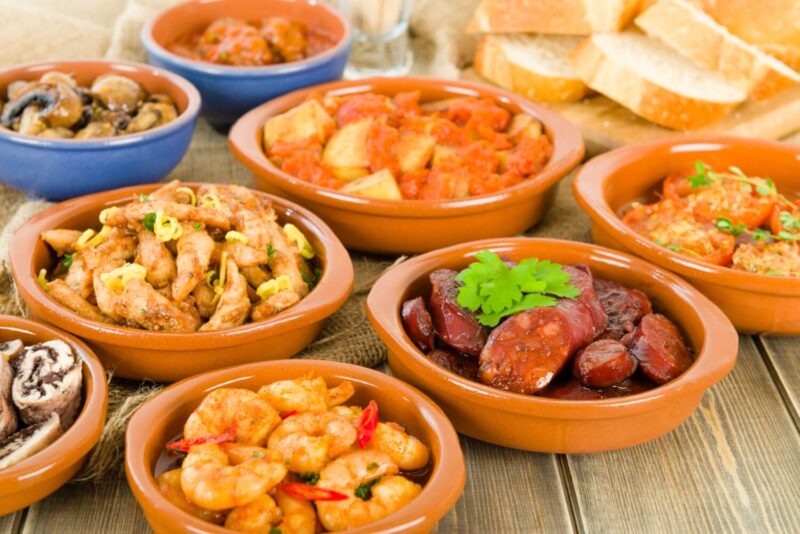
Seville is often referred to as the home of tapas, and unsurprisingly, there are 100s of tapas bars across the city, including the famed oldest tapas bar in Spain, El Rinconcillo. While we certainly recommend visiting Seville to sample tapas in its hometown, tapas bars are plentiful across Spain and there will always be a tapas bar just around the corner. Check out our guide to Seville restaurants and our Seville one-day itinerary for top tips on where to sample the best tapas and what to do in Seville.
There are hundreds of tapas dishes to choose from but here are a few of our favourites that we think are a must to try when in Spain:
- Patatas Bravas
- Braised ox cheeks
- Padron peppers
- Calamari
- Fried fish
- Tortilla
- Croquettes
- Chorizo
- Manchego cheese
- Selection of hams
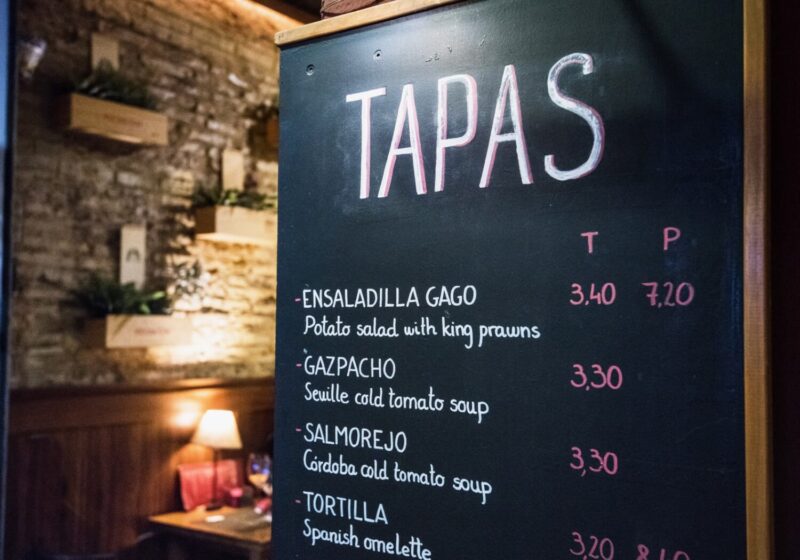
Pintxos
Similar to tapas, Pintxos are small meals but they are individual pieces usually on a small stick. Pintxos often consist of a piece of sliced bread with food on top such as fish, croquettes, tortilla, cheese and ham. While many pintxos are traditional, there are also lots of creative and elaborate versions and some that do not use bread at all.
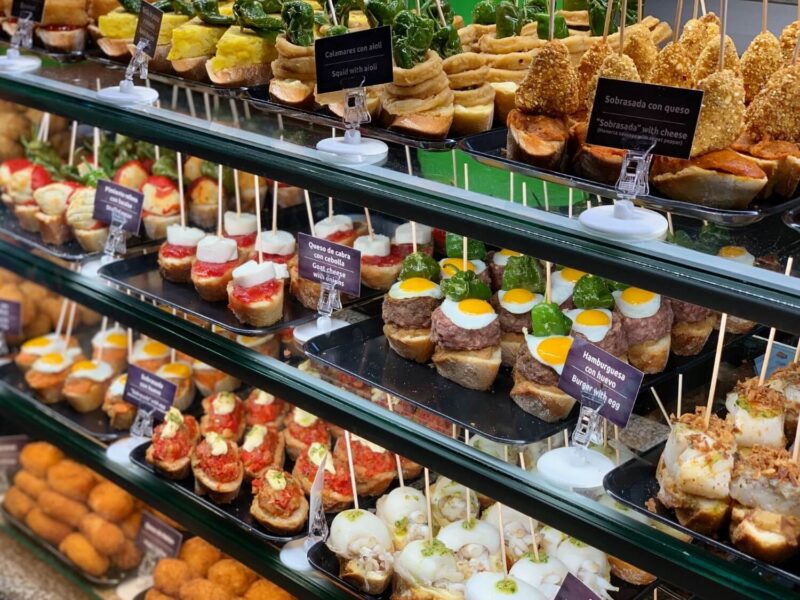
The word pintxos derives from the Spanish word ‘pincho’ which means spike, hence the skewered nature of the pintxo. Pintxos originated in San Sebastian in Spain’s Basque region and were created as a miniature alternative to tapas that could be displayed along the bar. They were then kept together with a wooden stick on bread and later the food became popular across the Northern region of Spain.
Cold pintxos are often displayed along the counter in pintxo bars while hot pintxos can be ordered from a menu. Similar to tapas, pintxos are a very social food and it is common for locals to go from bar to bar, drinking and sampling a few pintxos at a time. Different bars will have different pintxos and it’s common to go to one for the best ham pintxo and the next for the best tortilla pintxo and so on.
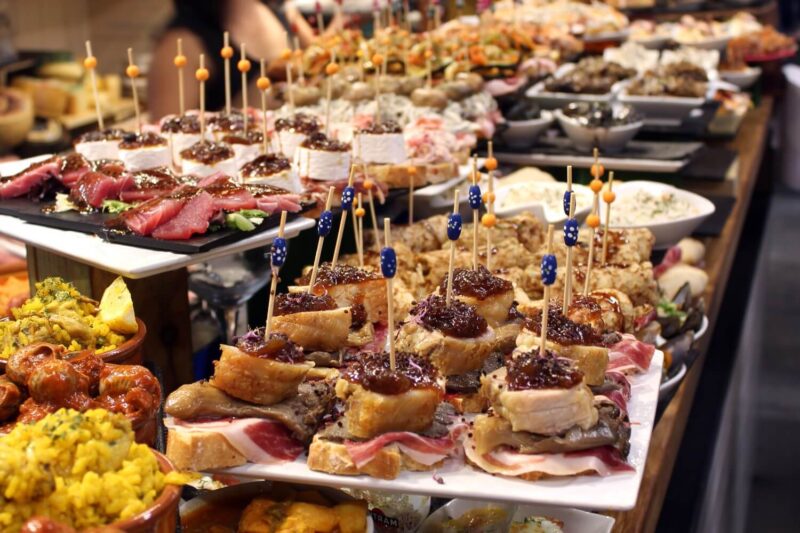
The best and largest range of Pintxo bars can be found in the Basque region, particularly in San Sebastian, one of the most famous cities for food in Spain. However, many of Spain’s largest cities have pintxo bars such as La Taberna del Pintxo, one of our favourite restaurants in Malaga.
Bocadillos
A bocadillo is a Spanish sandwich. The sandwich is usually made with Spanish bread, which is a baguette-style bread filled with a variety of ingredients. This is a low-cost meal and is common across Spain but has regional variations, like many Spanish foods. If you’re looking to travel to Spain on a budget then eating a bocadillo now and again is a good way to save some money.
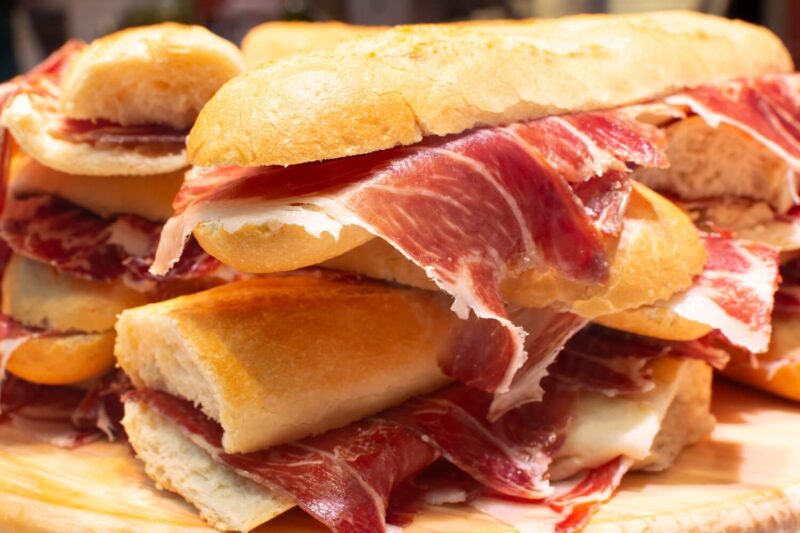
The humble bocadillo is often eaten in cafes and tapas bars and comes with a large range of filling options. Some of the most common are ham, cheese, tortilla, tomato and calamari. While calamari may sound like an odd choice of filling, it is delicious and often comes with aioli sauce. The calamari bocadillo is a speciality of Madrid and one of the best places to try it is at Bar Campana, near Plaza Mayor.
A bocadillo is often served with only one filling, besides ham and cheese. There’s sometimes a sauce but this will be used sparingly as it’s about appreciating the main ingredient and its flavour. They are best enjoyed with a cold beer or a glass of wine, as are most things.

Paella
The national dish of Spain and arguably the most famous dish of Spain, paella is comforting, hearty, full of flavour and constantly evolving. Paella is a Spanish rice dish which involves cooking short-grain rice in a delicious stock in a large shallow pan with a variety of ingredients such as meat, seafood and vegetables. The ingredients and stock vary from region to region but the general makeup of the dish remains the same throughout Spain.
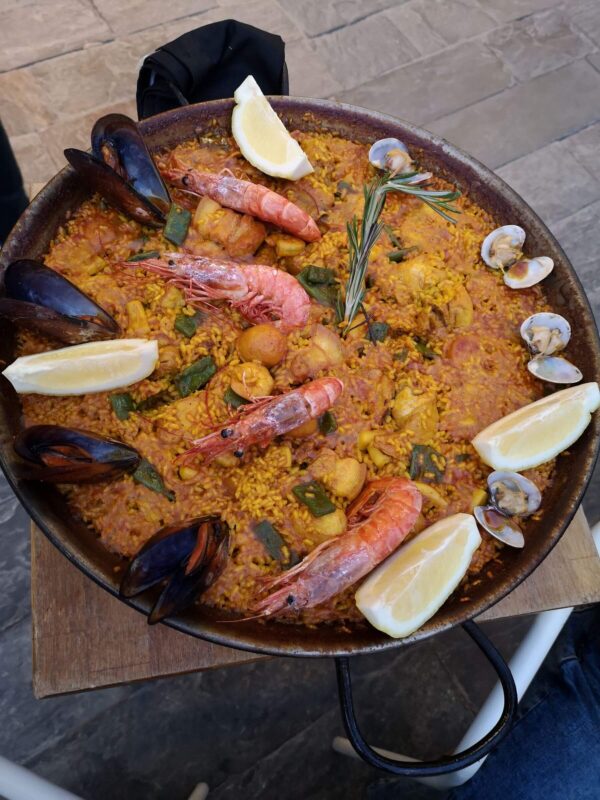
Paella comes from Valencia in Spain and was originally served as short-grain rice cooked in chicken stock with rabbit, chicken, green beans and lima beans. The yellow colour of the rice is usually from saffron. The name of the dish comes from the large pan it is cooked in, which is called a paella in the local Valencian dialect.
Variations of the dish are common across Spain including mixed paella with meat and seafood, seafood paellas and black squid ink paella. The most important part of the dish is often considered to be the stock used as this is what gives the rice and all the ingredients such a rich and powerful flavour.
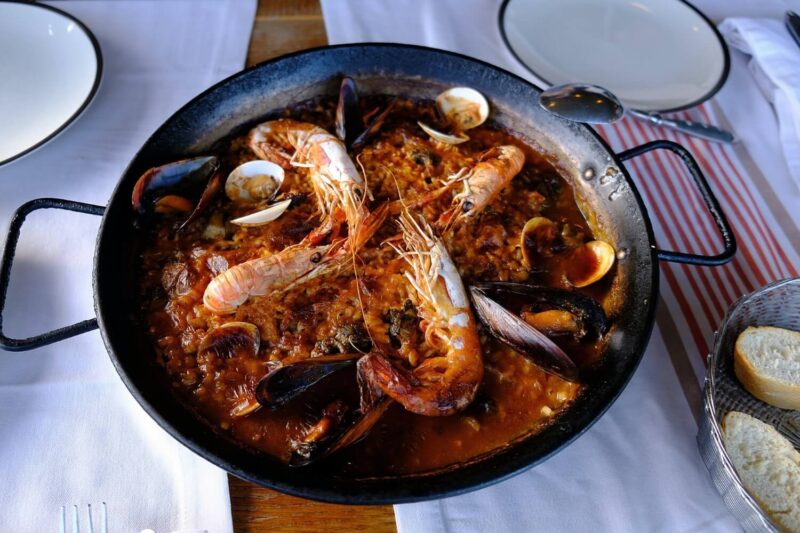
While we’d recommend visiting Valencia for the paella, and it’s beautiful city, paella can be found all across Spain so you’ll have no trouble sampling some when visiting Spain. However, it’s good to do some research on where to have paella as well as avoid particularly touristic locations, as paella can lack in quality and authenticity in some areas like this.
Empanadas
These tasty little snacks are a lesser-known Spanish food but are delicious and should not be missed while visiting Spain. Empanadas are folded baked or fried dough snacks filled with a variety of ingredients. They are common throughout Spain and the Latin-America region.
Similar to many other Spanish foods, the origins of the empanada aren’t clear but it is thought that they started in Galicia, in north-western Spain. Originally the empanadas would have been made similar to a large pie and cut into slices but as time moved on, they were more commonly made into small, individual turnovers, making them more convenient. The name empanada comes from the Spanish word ’empanar’ which means to coat in bread.
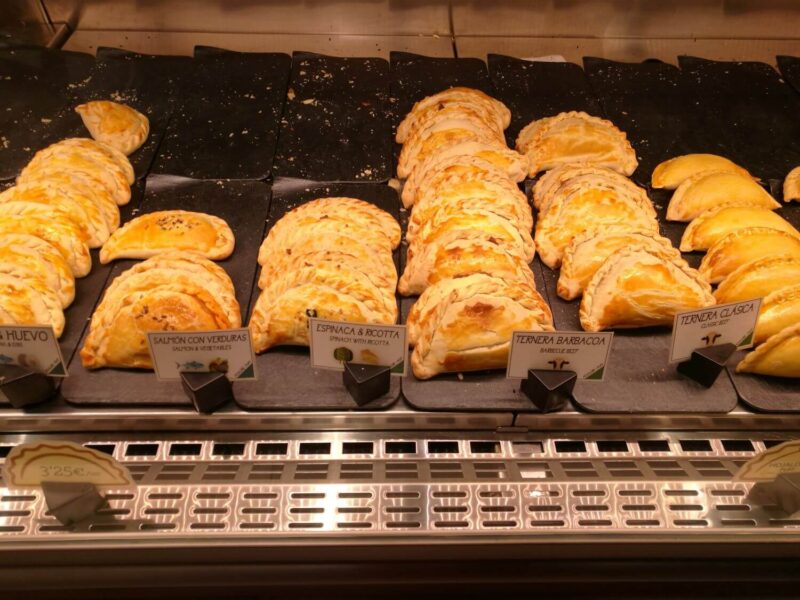
Traditionally, empanadas were filled with minced beef and this is still one of the most popular fillings today. However, you can now get fillings such as ham and cheese, potato, various meats and pork and apple, among others.
While it’s not the home of the empanada, if you’re visiting Madrid, check out the extensive empanada selection at the empanada stand in San Miguel market, also one of the top things to do in Madrid, which often includes fillings such as spicy beef, chicken and curry, mushroom and rabbit.
Iberian Pork And Hams
Iberian pork is a delicacy of Spanish meats. The pork is specific to the Iberian peninsula which covers Spain and central and southern Portugal. Iberian ham or pork is a product of black Iberian pigs which have a very specific diet and lifestyle to produce such rich, tasty and high-fat content meat.
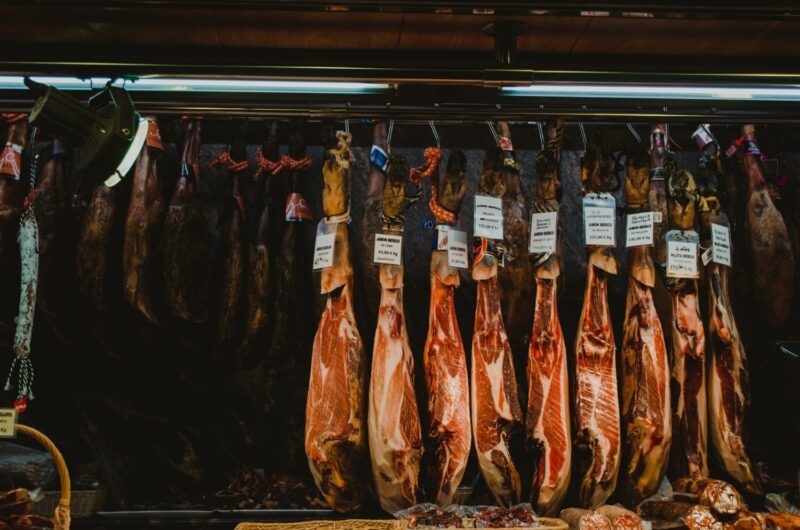
Although steaks of Iberian pork can be found, it is most commonly prepared as Iberian ham. The ham is dried in salt and then cured for 24-48 months. It is usually sold or served as slices or a leg of ham. While you can get Iberian ham across Spain, we recommend visiting some of the many food markets in Spain to sample some of the best Iberian ham in an authentically Spanish setting. Check out our Malaga walking tour where we start in Malaga central market which is full of amazing Spanish food!
It is common for the ham to have flecks in it which are the fat in the meat which gives it its rich flavour. Iberian ham is common as a tapas dish, as a starter or in bread. It is truly delicious and is one of our most recommended Spanish foods to try.
While we would have loved to have covered all of the best Spanish food, we haven’t, and this is merely just some of our favourites and a drop in the ocean when it comes to the variety and abundance of delicious Spanish foods available to try. Check out our Spain travel guides for extensive travel guides to destinations across Spain including Seville, Madrid and Barcelona. Let us know in the comments below if you have visited Spain and what some of your favourite foods were.
Pin this article to save it for later or share it with others
